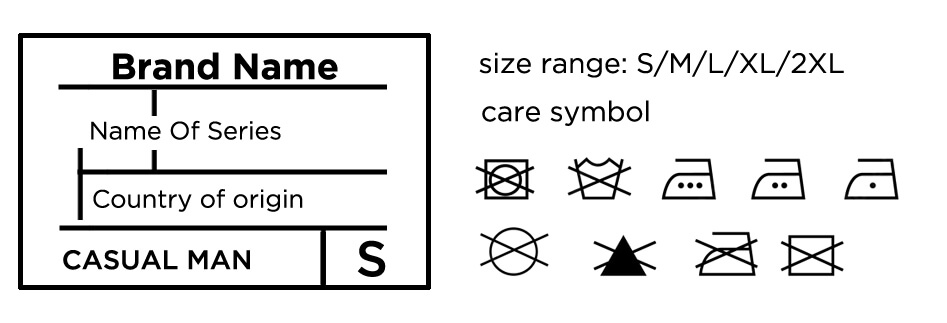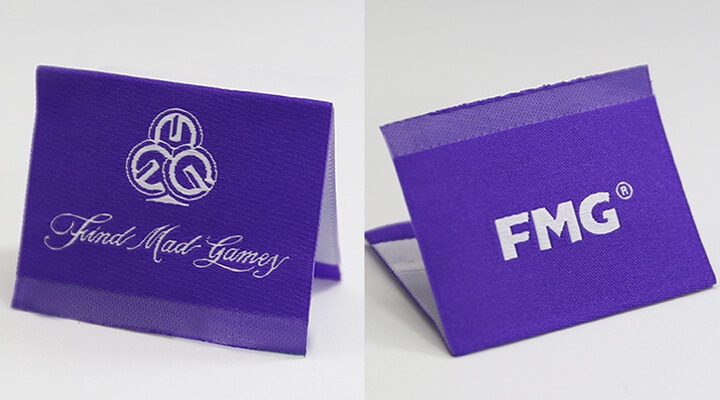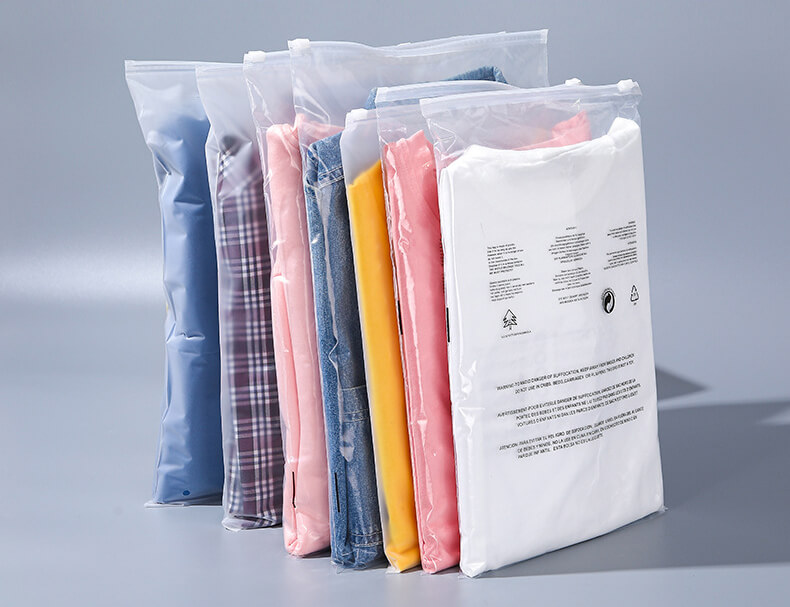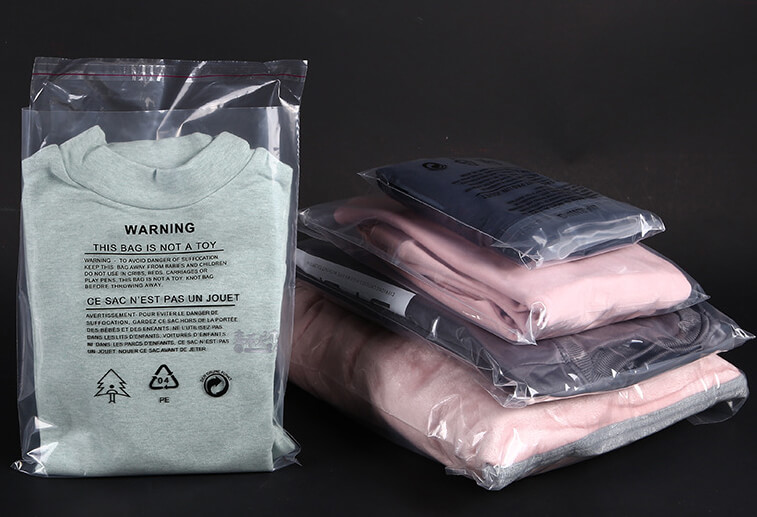Why do we need to make private labels and customized packing bags?
Using custom clothing packaging is an effective way to promote a product. The packaging of any product will directly affect the customer’s response to a specific brand, which is why customized clothing packaging can make a difference for clothing labels.
- Clothing packaging reflects the brand’s ideology and expresses the emotions that customers develop around a clothing line.
- It is well known that high-quality custom shirt packaging can influence the total revenue of a clothing brand because more and more customers are attracted to well-packaged clothing products.
- Customized packaging can help you stand out from the competition, promote brand awareness, and create an emotional connection with customers.
Therefore, clothing brands must invest in quality private labels and hang tag packaging. They can only hope to compete in today’s market and build long-term relationships with their customers.
Labels
What are neck label and their purpose?

Your clothes probably contain a neck label without you even knowing it! Neck labels are pieces of fabric sewn or printed onto the inside back of a garment, around the neck area. They usually contain important information about the garment, like the size, care instructions, and sometimes the country where it was made. The information on neck labels is regulated by government agencies, but there’s still some room for customization. For example, brands and small businesses can choose their own colors and fonts for their neck labels. Next time you try on clothes, see if you can spot the neck label!
What are care label and their purpose?

Care labels are an essential part of garment care. They provide consumers with guidelines on the best cleaning procedures for specific combinations of fabrics, thread trim and construction techniques. Following the instructions on the care, the label ensures that the appearance and fit of the garment are maintained after repeated cleaning treatments.
Care labels serve as a cleaning guide and can influence purchase decisions. Garments that are easy to care for are often preferred over those with complex or difficult-to-understand care procedures. Many different care labeling systems have been developed around the world. Some have been developed as government regulations, while others are international standards. However, not all of these are mandatory. Care labels are a small solution to a big problem and provide essential information for proper garment care.
Important tips: care labels must include the country of origin. Especially when you import products from oversea countries.







What size should labels be?
When you are designing your own clothing labels, it is important to choose the right label size, which depends on where you want to place it on the product.
We have size recommendations for all our Custom Clothing Labels 100%, which we want you to follow. Please contact us if you can’t find the size you’re looking for or have specific requirements, so we can assist you further. We guarantee that your experience with us will be perfect!
- Determine the size
Determining the size of a label by eye can be tricky- luckily, there are a few simple ways to get an accurate measurement.
One method uses a ruler to measure the width (from left to right) x height (from top to bottom).
You could also take a piece of paper and draw the label’s dimensions.
If you have a product with a label that you like the size of, you can also measure that.
- Common label sizes
The most common label sizes for different clothing items will depend on the retailer from which the clothes are bought. However, there are certain standards that the majority of retailers use.
Neck Tag
T-shirt branding tag size: 2″x2″ with loop (center) folded to 2″x1″
2.5″x0.5″, end folded to 2″x0.5″
Hem branding tag
1 “x2” folded into 1 “x1”
Dress and pants
2.25″x0.375″ with ends folded to 1.75″x0.375″
Dress and pants
2.25″x0.375″ folded at both ends to make 1.75″x0.375″
sewn on the inner seam
Care label
Place next to/under the inner seam or main label Men’s: 1.2″x1.8″ ring (center) folded to 1.2″x0.9″
Women’s: 0.7″x2″ ring (center) folded to 0.7″x1″
Size label / Care instructions label / Country of origin
Different material labels

- Woven label

(Colors & size : can be any color and any size you need)
Woven labels are created by weaving polyester threads together on a loom to present your desired designs and messaging. Cotton and polyester are the two most common materials used to make woven labels.
Not only are your designs woven into the label but the entire label is woven. The fact that the entire label is woven gives them an appealing soft feel, but they are also durable. A woven label is an excellent way to add a touch of sophistication to your garments. Individual stitches provide a more durable appearance. It’s a high-end option that adds a touch of class to any outfit. However, it is not as soft as cotton and satin labels.
- Satin polyester

(White, cream, grey, black)
Available widths: 15 mm, 18 mm, 25 mm, 32 mm, 38 mm
Satin polyester is a very popular fabric for apparel labels. It is soft and smooth, making it comfortable to wear. The fabric is also woven, so the edges are sealed and won’t come apart. The colors are rich and vibrant and will not fade in home laundering. However, satin polyester is not recommended for use in industrial laundry environments. If you are looking for a beautiful and durable fabric for your apparel labels, satin polyester is an excellent choice.
- Nylon

(white only)
Available widths: 3/4″, 1″, 1-1/2″
Nylon is a great general-purpose label material. The surface is very smooth, so small letters and fine details can be printed clearly. The coating on this material prevents wear and holds ink for added durability. Nylon labels will easily stand up to home laundry and will not fade in industrial laundries. This makes it perfect for applications where the label needs to withstand a lot of wear and tear, such as clothing care labels. Nylon is available in black only, in three different widths. Choose the width that best fits your application.
- Cotton label

(Stock Colors: White, Beige, Black; Custom Colors: any colors you need)
Available widths: 1/2″, 3/4″, 1″, 1-3/8″, 1-1/2″
Cotton labels are made from natural fibers. Cotton is off-white in color, and can be dyed to match any shade. It is very soft and comfortable to wear next to the skin. Cotton is also very versatile, as it can be dyed in various colors. A cotton label is a great option if you need an eco-friendly and versatile label material.
Hang tags
What are hang tags and their purpose?

The retail hanging tags are a small cardboard or plastic label that hangs on a garment and provides information on size, color, fabric and price. Hangtags are usually printed on both sides, with the front side containing the brand name and logo, while the back provides more detailed product information.
What size should the branding tag be?
Luxury hang tags of clothing can come in various sizes, with the smallest being 1.375 × 2.75 inches and the largest being 5.125 × 10.25 inches.
| Hang Tag Size | Dimensions (inches) |
|---|---|
| #1 | 1.375 × 2.75 |
| #2 | 1.625 × 3.25 |
| #3 | 1.875 × 3.75 |
| #4 | 2.125 × 4.25 |
| #5 | 2.375 × 4.75 |
| #6 | 2.625 × 5.25 |
| #7 | 2.875 × 5.75 |
| #8 | 3.125 × 6.25 |
| #9 | 3.625 × 7.25 |
| #10 | 4.125 × 8.25 |
| #11 | 4.625 × 9.25 |
| #12 | 5.125 × 10.25 |
Different materials for hanging tags

- Hangtags made of paper.
- Hangtags made of metal.
- Hangtags made of leather.
- Textile material hangtags.
- PVC plastic material hangtags, rubber, wood. Various mixed materials are ideal for garment hangtags.
Paper material
- Paper materials for garment hang tags
There are a variety of paper materials that can be used for garment hangtags.
- Coated paper is a popular choice as it provides a smooth surface that can be easily printed.
- Special paper, such as kraft paper, is also often used for hangtags as it has a more natural look and feels.
- Single-sided and double-sided cardboard are also common choices, as they are sturdy and can be easily cut to size.
- Insulating and corrugated paper are also sometimes used for hangtags, providing extra durability.
- Ultimately, various paper materials can be used for garment hangtags, and the best choice will depend on the project’s specific requirements.
Metal materials
Metal materials are widely used in manufacturing clothing tags. They include copper, iron, alloy and stainless steel, which offer durability and attractiveness. In addition, metal materials are suitable for jeanswear as tag materials for jeans garments, serving as a key chain material to highlight the garment style.
Metal tags are usually connected to clothes by thin metal wires or chains. The methods of connection vary with the thickness and weight of different metals.
Leather material
Leather is a sturdy, long-wearing fabric created from the skin of certain animals. It is strong and durable, making it ideal for the clothing worn often. Leather is also a luxurious material, adding a touch of sophistication to any outfit. However, leather is not always the best choice for clothing tags.
In particular, leather can be difficult to attach to delicate fabrics such as silk.
Fabric labels
Fabrics include canvas, silk, synthetic fibers, and cotton fabrics. However, the fabric’s weave is very suitable for casual wear and stringing of labels. So it’s good for people’s skin.
Other materials
Many other materials can be used for clothing tags. PVC, rubber, wood and various types of composite materials are all suitable choices that can help improve a brand’s value.
Packing bags
What is packing bag and the purpose?

Packing bags are an essential part of the custom clothing production process. A well-designed packing bag can significantly affect how customers react to a particular brand.
Clothing packing bags reflect the brand’s ideology and express the emotions that customers have developed around a clothing line. It is well known that high-quality custom shirt packaging can impact a clothing brand’s total revenue, as more and more customers are attracted to beautifully packaged clothing products.
Different types of packing bags


What size should packing bags be?

When it comes to custom clothing packaging bags, one size does not fit all. The bag size will depend on the type of clothing being packaged. For example, a bag for a t-shirt will be different than a bag for a dress or a suit. Choosing the right bag is important so the clothing can be properly protected and displayed.
If you are unsure of what size bag to use, you can always consult with a professional packaging company. They will have experience in choosing the right size bags for different types of clothing and can help you find the perfect solution for your packaging needs.
Different materials for packing bags
Tradition packing bags are made of EVA, PP, and PE.
As awareness of the need for sustainability grows, many clothing manufacturers are beginning to make eco-friendly choices to make their businesses more sustainable in the future. Many custom shirt bag manufacturers offer options such as PLA bags which are made of corn starch and paper bags which are made of trees. But the final decision still lies with which material your brand needs.
Tips: Biodegradable bag costs twice as much as PP bag.
Wrapping up
Your clothing brand’s tags, hangtags, and packaging bags are important because they help convey your brand message, attract customers, and protect your clothing products. By selecting the right materials and sizes, you can ensure that your packaging reflects your brand in the best way possible.
